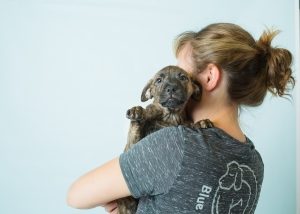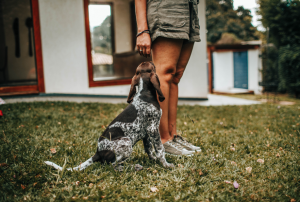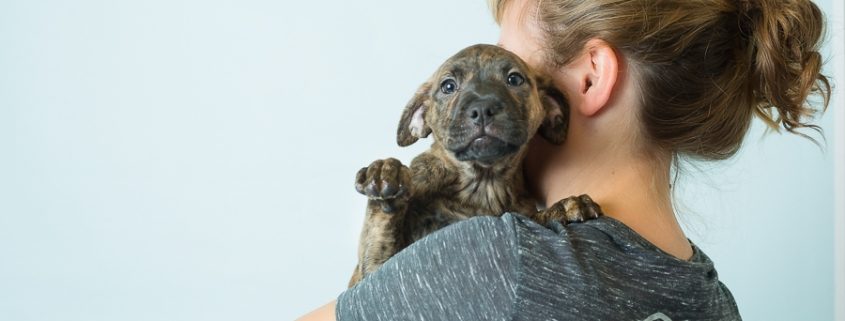Ask Crystal: Puppy Training 101

Dear Crystal,
I have a 9-week-old puppy and I’ve had him for a grand total of three days. Although he sometimes fusses in his crate, I do wait a bit or let him out when he is walking around but not fussing after a nap. My only problem is the training for other behavior such as biting and going to places he shouldn’t be going to, most videos I see uses treats or toy as reinforcement. However, my puppy seems disinterested in either. What should I do?
Hoping you could give me some tips!
Sincerely,
New Puppy Parent
Dear New,
Congratulations on your new addition! I know how stressful adding a new family member is. Especially with puppies, we question every decision and whether we are doing things right. I am so happy to hear you are already thinking about his training! Hopefully, we can get you on the right path to training a healthy and happy puppy.
In regards to his interest in toys and food at the moment, my best guess is that your puppy is stressed from the move to your house. This isn’t to say it’s impossible for a puppy to not be interested in food or toys but in a happy, healthy puppy, it is pretty unlikely. We often test whether a dog will eat a treat to see where they are emotionally. Many dogs will not eat even a high value item when stressed but some dogs will. Dogs will not play when they feel afraid so it’s a pretty good litmus test to see if they are feeling afraid or stressed. Feeling stressed out in the beginning is totally normal and it will pass if you give them some time to settle in.
We usually suggest a decompression period when a new animal comes home to allow them time to settle in without a lot of activity or pressure on them. This means training can wait until he is behaving normally. That would mean eating, playing, going to the bathroom, etc. It isn’t going to harm anything to give him a little time where he just gets support where he needs it.
When I got my newest puppy, he would scream bloody murder if I tried to put him in a pen when he first came home. I slept with him on the couch the first week while we worked on crate training during the day. Once I got him comfortable being in the crate, we tried crating at night. There was some mild crying and then he went to sleep for a while. He is very crate trained now and I don’t believe there were any setbacks from giving him some time in the beginning with whatever he needed at that moment. It’s pretty scary for a puppy to be taken away from everything they know and be placed in an all-new place with new people and new rules so we shouldn’t be too hard on them.
 After you have given him a week or two to settle in, you can try some low-pressure training. This is training where there isn’t a lot of looming over the dog or pressuring it. We usually start with conditioning the mark word of “yes”. Simply say “yes” and then feed a treat or kibble, repeat until his ears start to perk up. Name Game is one of the first things I work on because it is the foundation of recalls and leash walking. Start by saying his name, then “yes” and treat. The next step would be when he is turned away and mildly distracted, call his name once in a high-pitched tone of voice. When he turns to look at you, say “yes” and hold a treat by your leg and wait for him to come get it. Find It is a very useful cue and fun for most dogs. Toss a treat in the grass and say “find it” and keeping tossing and repeating “find it” while he searches the grass.
After you have given him a week or two to settle in, you can try some low-pressure training. This is training where there isn’t a lot of looming over the dog or pressuring it. We usually start with conditioning the mark word of “yes”. Simply say “yes” and then feed a treat or kibble, repeat until his ears start to perk up. Name Game is one of the first things I work on because it is the foundation of recalls and leash walking. Start by saying his name, then “yes” and treat. The next step would be when he is turned away and mildly distracted, call his name once in a high-pitched tone of voice. When he turns to look at you, say “yes” and hold a treat by your leg and wait for him to come get it. Find It is a very useful cue and fun for most dogs. Toss a treat in the grass and say “find it” and keeping tossing and repeating “find it” while he searches the grass.
The biting you are referring to, I assume is puppy mouthing. I have written a few posts of how to deal with this behavior if you search puppy mouthing on the blueridgehumane.org news section. This behavior is totally normal for a puppy and will get better with time if you redirect him onto appropriate toys or a well-timed time-out where you leave the room when he bites too hard. I will say that having a dog for him to play with is the best way to work on mouthy behavior so if you don’t have a dog, look for friends with dog friendly dogs to set up playdates.
Management is key for keeping the puppy out of places where he should not be. Places he should not be are basically anywhere you are not or where you can’t see him. If we can’t see the puppy, we can’t interrupt and redirect inappropriate behaviors. You can use baby gates or shut doors to keep him in certain areas. Many people favor the umbilical cord method with puppies where you attach them to your belt and they go everywhere with you. You can also use a tie down to attach them to doors or a heavy piece of furniture. Pens can be used unfolded to block larger areas. This will keep him out of areas without needing treats.
When the puppy is chewing on something he shouldn’t or in a place he shouldn’t be, you can use a positive interrupter. This is a noise or a word that you condition the dog to. You train it the same way as the Name Game except you make a noise or say a different word than his name. I prefer to use this to interrupt versus the dog’s name as it can impact the dog’s recall if you are consistently calling them away from fun activities. When the pup is doing something he shouldn’t be doing, make the interrupter noise and say “yes” and treat when he comes back to you. Then you can redirect to a different activity. This is where it is a good thing that pups only have a 1 second association period.
 It is good to do a reinforcer preference test with him when you are working on training. Once he feels more comfortable, get several different kinds of treats and see how he reacts to each one and you can make a preference list. Use high value treats when you are teaching a new behavior or are in a new location. You can use lower value treats when the behavior is known and/ or in an easy location like at home. A lot of people try to use dry dog biscuits in training class and that is usually not going to cut it in a distracting environment.
It is good to do a reinforcer preference test with him when you are working on training. Once he feels more comfortable, get several different kinds of treats and see how he reacts to each one and you can make a preference list. Use high value treats when you are teaching a new behavior or are in a new location. You can use lower value treats when the behavior is known and/ or in an easy location like at home. A lot of people try to use dry dog biscuits in training class and that is usually not going to cut it in a distracting environment.
For most dogs, food is going to be the highest value reinforcer. It’s the quickest way to get a lot of repetitions in. Once he knows a behavior, you can start using real life rewards as well in order to incorporate nonfood rewards. This would be things like asking him to sit before you throw a ball, put on his harness, let him outside, put down his bowl, etc. Anything that he likes you ask him to do a behavior first. This doesn’t mean you won’t use food rewards anymore but you will be able to use less and you will find the dog is much more cooperative if you incorporate a variety of reinforcers.
I am sure that given some time you will be able to use food reinforcers to train your pup. Be patient with him and he will settle in. Good luck and happy training!
Until next time,
Crystal
Submit your own pet behavior question for Crystal here:







